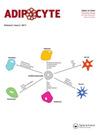Myostatin increases the expression of matrix metalloproteinase genes to promote preadipocytes differentiation in pigs
IF 3.5
4区 生物学
Q2 ENDOCRINOLOGY & METABOLISM
引用次数: 1
Abstract
ABSTACT Myostatin (MSTN) resulted in reduced backfat thickness in MSTN-knockout (MSTN-KO) pigs, whereas the underlying mechanism remains elusive. In this study, RNA sequencing (RNA-seq) was used to screen differentially expressed genes (DEGs) in porcine fat tissues. We identified 285 DEGs, including 4 adipocyte differentiation-related genes (ADRGs). Matrix Metalloproteinase-2/7 (MMP-2/7), fibronectin (FN), and laminin (LN) were differentially expressed in MSTN-KO pigs compared with wild-type (WT) pigs. To investigate the molecular mechanism, we treated the preadipocytes with siRNA and recombinant MSTN protein. The results indicated that MSTN increased the expression of MMP-2/7/9 and promoted the preadipocyte differentiation. To further validate the effect of MSTN on MMP-2/7/9 expression, we treated MSTN-KO PK15 cells with recombinant MSTN protein and detected the expression of MMP-2/7/9. The data showed that MSTN increases the expression of MMP-2/7/9 in PK15. This study revealed that MSTN promoted preadipocyte differentiation and provided the basis for the mechanism of fatty deposition in pigs.肌生长抑制素增加基质金属蛋白酶基因的表达,促进猪前体脂肪细胞分化
ABSTACT肌肉抑制素(MSTN)导致MSTN敲除(MSTN-KO)猪的后鳍厚度减少,但其潜在机制仍不明确。在本研究中,RNA测序(RNA-seq)用于筛选猪脂肪组织中的差异表达基因(DEGs)。我们鉴定了285个DEG,包括4个脂肪细胞分化相关基因(ADRG)。基质金属蛋白酶-2/7(MMP-2/7)、纤连蛋白(FN)和层粘连蛋白(LN)在MSTN-KO猪中与野生型(WT)猪相比有差异表达。为了研究其分子机制,我们用siRNA和重组MSTN蛋白处理前脂肪细胞。结果表明,MSTN可增加MMP-2/7/9的表达,促进前脂肪细胞分化。为了进一步验证MSTN对MMP-2/7/9表达的影响,我们用重组MSTN蛋白处理MSTN-KO PK15细胞,并检测MMP-2/7/9的表达。结果表明MSTN可增加PK15中MMP-2/7/9的表达。本研究揭示MSTN促进猪前脂肪细胞分化,为猪脂肪沉积机制提供了基础。
本文章由计算机程序翻译,如有差异,请以英文原文为准。
求助全文
约1分钟内获得全文
求助全文
来源期刊

Adipocyte
Medicine-Histology
CiteScore
6.50
自引率
3.00%
发文量
46
审稿时长
32 weeks
期刊介绍:
Adipocyte recognizes that the adipose tissue is the largest endocrine organ in the body, and explores the link between dysfunctional adipose tissue and the growing number of chronic diseases including diabetes, hypertension, cardiovascular disease and cancer. Historically, the primary function of the adipose tissue was limited to energy storage and thermoregulation. However, a plethora of research over the past 3 decades has recognized the dynamic role of the adipose tissue and its contribution to a variety of physiological processes including reproduction, angiogenesis, apoptosis, inflammation, blood pressure, coagulation, fibrinolysis, immunity and general metabolic homeostasis. The field of Adipose Tissue research has grown tremendously, and Adipocyte is the first international peer-reviewed journal of its kind providing a multi-disciplinary forum for research focusing exclusively on all aspects of adipose tissue physiology and pathophysiology. Adipocyte accepts high-profile submissions in basic, translational and clinical research.
 求助内容:
求助内容: 应助结果提醒方式:
应助结果提醒方式:


